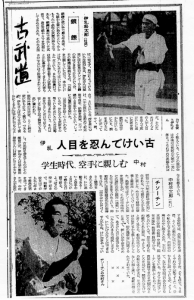Kobudō 2: Irei Matsutarō and Nakamura Heisaburō
[ Okinawa Times ] November 16, 1961
Kobudō 2
Training secretly
Irei Matsutarō (82)
Kusarigama
Expert of Kusarigama – sickle and chain weapon, and the eldest senior, he started learning when he was 19 years old, which makes him a man with a martial art experience of more than 60 years. Kusarigama is a martial art that was developed in farm villages where people thought of linking the familiar chain and sickle into a single weapon. Therefore, while there is not one defined kata, many forms can be found depending of the region. Mr. Irei learned Kama-no-te from Asato no Tanmei (1) who lives in Goeku (2). However, his motive was quite simple. He explains that “I was aspiring to become a soldier and I didn’t want to be laugh at when going in Mainland Japan…” Also, at that time in farming villages, people who studied karate and sickle were hated as they were considered as savages and thugs. People kept away from them even to the point that they couldn’t find a spouse. For such reasons, most people were studying martial arts incognito at night, away from people’s attention.
He first started with karate and with his skill leveling-up, he studied many other techniques like Sai, Bō and Kama. At 25 years old, he demonstrated for the first time karate and Kusarigama in a play put on in a village and at 31, he performed a large demonstration together with 12 students.
People are told that “Gei ha mi wo tasuku (3).” Mr. Irei himself says that he was able to overcome many disasters because he studied martial arts. This is not simply a question of defending oneself but also to nurture naturally a spirit that helps one to endure hardships.
Nowadays, the number of experts in Okinawa Kobujutsu and especially sickle is diminishing but he is happily teaching all those who sincerely intend to learn the sickle. During the next coming demonstration, many experts of Okinawa Kobujutsu will gather to demonstrate their secrets and it is the purpose of all to popularize Kobujutsu. On his own, Mr. Irei is teaching Sai, Kama and other skill to his grandchild Tomita Nobuyuki (24).
(1) Tanmei is a word that could be translated into grandpa or old man.
(2) Goeku is located in Okinawa City or Koza.
(3) Learn a trade, for the time will come when you shall need it.
Becoming intimate with karate during student days
Nakamura Heisaburō (68)
Chisōchin
He was born in 1893 in Motobu Town Aza Toguchi. When around 17 years old, he got to know karate and until this day, he has continue training as a spiritual cultivation and as a way of staying in good health. During the demonstration, he will perform Chisōchin (1), a kata he says he was initiated to when he was a student by Bushi Kuniyoshi (2) of Nago Town. During the time of Shihan (3), he received instruction from Yabu Kentsū sensei.
About the merits of karate, he tells with a peaceful tone that “Karate is a good exercise to build a strong body and to temper the mind…” A fervent karate enthusiast, after graduating from the Teachers’ College he spent his life as a school teacher until 1957. In each school he was newly appointed, he instructed karate to students. Especially to upper students, he taught Pin-an and kumite among other things, including karate as a regular item of school’s athletic meets. He retired as principal of Motobu Elementary school in 1957 (4). He is presently the head of the Board of Education of Motobu district.
A man who gives a pleasant impression, with a well-balanced appearance forged through karate, he looks much younger than he is actually. Most likely, he was much appreciated by his students when he was a school teacher. Since it is the first demonstration he is participating in, he went looking for a new karategi and now he devotes himself completely to his morning training. “As I will perform in front of the public, I cannot do anything irresponsible. Although I keep training, I am getting old, and I am worried if I can perform well” he says humbly. Yet he can perform karate very powerfully. As he demonstrates Chisōchin facing the camera, his serious facial expression tells anyone that is still in good health. The sounds of joints and the agile handling of his body are such a contrast with his ordinary quiet face, that it fills the space with a dignified feeling.
Notes:
(1) In Japanese, it is written “Chi” and not “Shi” like for the Gōjū-ryu kata Shisōchin.
(2) Alias for Kuniyoshi Shinkichi (1848-1926). According to the “Okinawa Karate Kobudō Encyclopedia”, he was born in Kumoji Village (present Naha), learned Nahate and was considered the equal to Higashionna Kanryō. When 60 years old, he moved to Nago and taught the kata Nisēshi to Nakamura Shigeru of Okinawa Kenpō.
(3) Referring most likely to Shihan Gakkō, the Teachers’ College that was located where today stands the Okinawa Prefecture University of Arts.
(4) According to Motobu Town Motobu Elementary School records, he was appointed principal of the school in April 1946 (Showa 21) as the 15th principal.

